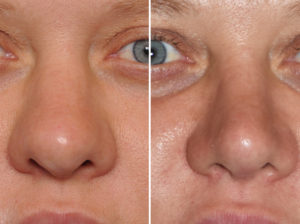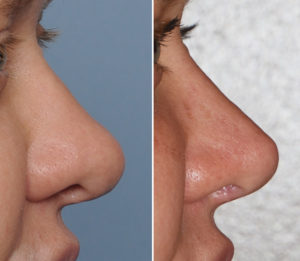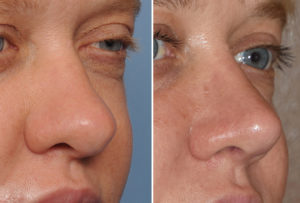Background: Rhinoplasty involves changing the nasal shape through changes in the underlying bone and cartilage support. The only location for skin removal in a rhinoplasty is when the nostril width is reduced through various patterns of tissue excision.Thus in the large nose any reductive efforts and their results are heavily impacted by how well the overlying soft tissue shrinks down and around the reduced structural framework. This is also why in any rhinoplasty it may take up to a year to see the final result as the skin adaptation process can take this long to fully occur.
In the thick skinned nose, regardless of ethnicity, it can be a real challenge to achieve the rhinoplasty results many such patients want. This is particularly true when the overall goal is to make the nose smaller and have a more refined shape. This challenge is magnified when the patient has already had prior rhinoplasty surgery. The best chance for the nasal skin’s ability to shrink down is the first time before scarring forever limits what can occur with subsequent manipulations.
Case Study: This 35 year-old female presented with a history of two prior rhinoplasties by another surgeon. It was not clear what changes were done inside the nose but she felt that her nose was actually bigger after these two efforts than before any surgery was done. Her initial and revision rhinoplasties were done 15 and 9 months previously.


The thick skinned revision rhinoplasty is a challenge and there are limits as to how much further improvement can be obtained. Thinning out the soft tissues of the nasal tip and proper supportive nasal tip cartilage reshaping can offer some improvement over prior rhinoplasty efforts.
Highlights:
1) The thickness of the nasal skin in any form of rhinoplasty poses limitations as to the quality of results seen.
2) Revision rhinoplasty in the thick skinned nose poses significant challenges in getting a smaller and more refined nasal shape result.
3) Defatting of the nasal tip and avoiding over resection or over plication of the lower alar cartilages can provide some narrowing of the thick skinned nose.
Dr. Barry Eppley
Indianapolis, Indiana



